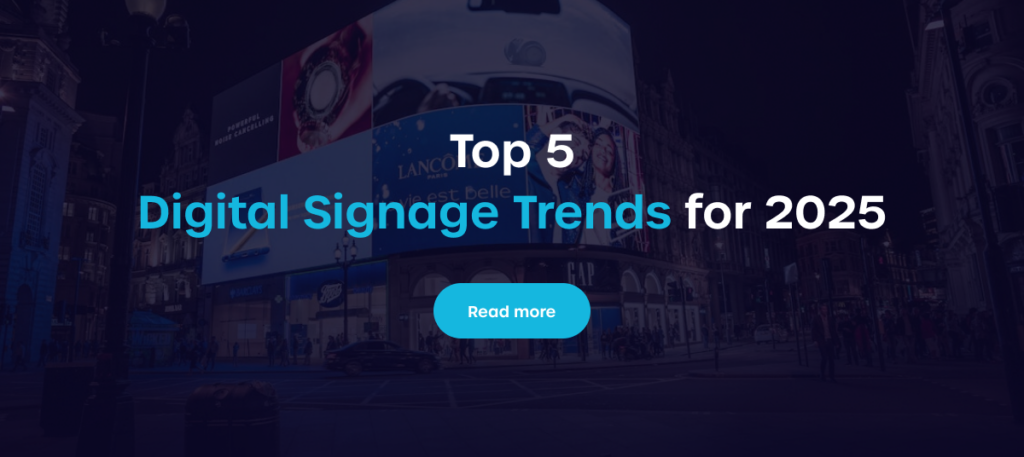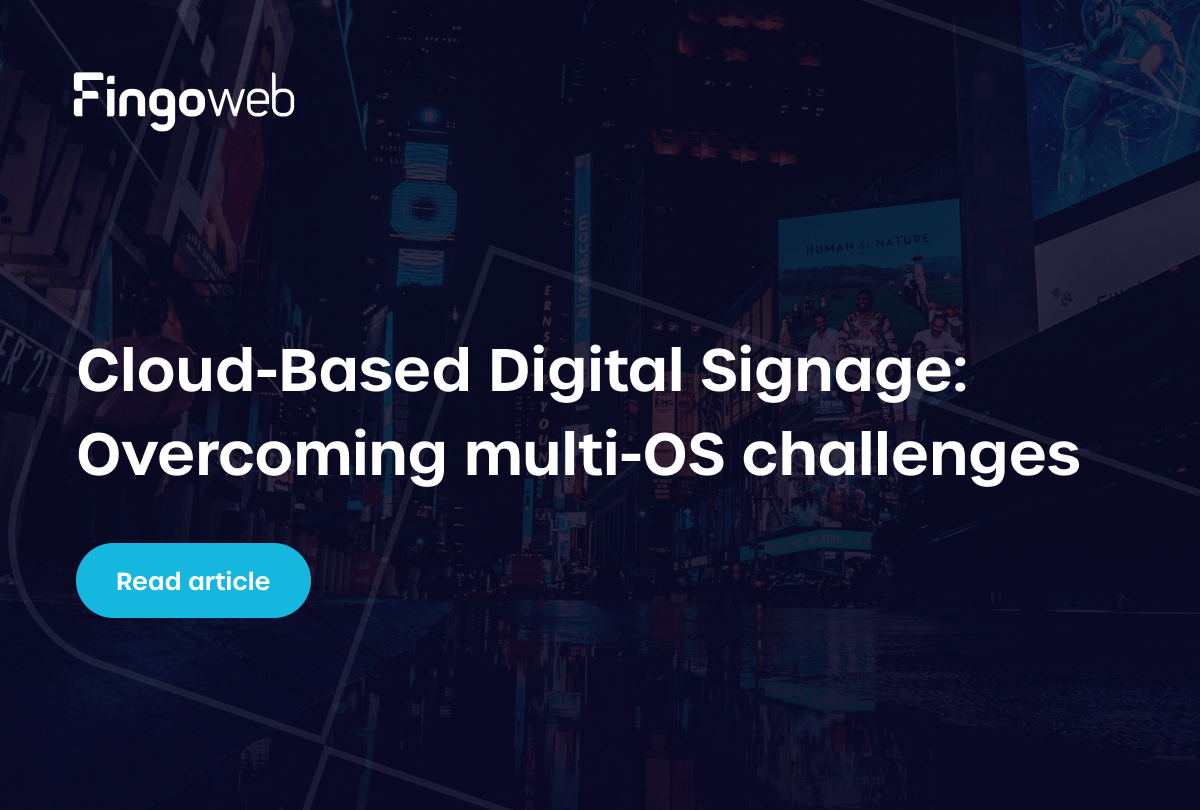The path of digital signage development can be summed up in two words: AI and personalization. Increasingly better tools, utilizing machine learning, allow for more efficient preparation of effective digital signage campaigns, with subsequent players moving towards personalization.
In this guide:
- Digital signage as you know it
- Devices and formats – from Apple to Samsung
- Micro LED and transparent screens
- AR and VR
- The issue of scale
- Interactivity and personalization
- AI content creation
- The future
In science fiction movies and video games, the motif of interactive, holographic ads recurs. Personalization, interactivity, and the use of AI are much closer than one might think. Tools for optimizing content displayed on digital signage players exist and are improving year by year.
We can divide the future of signage into:
- The development of receivers, including the popularization of AR/VR glasses, transparent screens, and the development of micro LED technology.
- The development of digital signage applications allowing for content personalization, also based on machine learning (e.g., classification models, computer vision).
- AI support in creating campaigns and content, at every stage – from data analysis and key decision-making, through content creation (e.g., replacing stock video or images).
We will go through each of the above points step by step, looking for potentially the most likely development paths in the coming years.

he development of the digital signage market goes hand in hand with technological advancements. We can already observe how the popularization of AI will affect market changes. Increasing emphasis is being placed on personalization, interactions, and finding new, interesting places to apply digital signage.
Digital Signage, as You Know It
Typically, digital signage screens are associated with menus displayed above gas station counters or interactive kiosks in clothing stores. Digital signage can be divided into two categories:
- Intended use; sales and marketing, entertainment, information dissemination.
- Location; outdoor, indoor, as kiosks or projectors projecting images onto walls.
You encounter signage screens every day, from pharmacies to shopping malls to local restaurants. The common denominator for most will still be their passive nature. While screens in successive clothing or jewelry stores in a shopping mall or interactive kiosks with maps are not surprising, a transparent LED screen displaying interactive information is still a rarity.
For this reason, let's start with the devices themselves.
Devices and Formats – From Apple to Samsung
In January of this year, during the CES trade show in Los Angeles, Samsung unveiled a new generation of transparent micro LED screens. Transparent LED screens are nothing new; LG has long offered LED and OLED transparent screens. However, micro LED technology allows for very precise color reproduction and high image quality.
Micro LED and Transparent Screens
Samsung is the largest TV manufacturer in the world, also recognizable in the signage segment. The Tizen operating system offers many possibilities to work with dedicated digital signage applications.
Transparent screens offer considerable possibilities in the world of signage. The ability to dynamically display content, such as supplementary information about the space behind the screen, can be used in advertising, entertainment, and informational industries, and even in healthcare facilities.

For example, in sports, Samsung provided an example of a huge, transparent screen mounted in VIP boxes during football matches, displaying current match information.
Transparent screens will require content tailored to such use.
AR and VR
The development of micro LED and transparent screens is also essential for the development of augmented reality and virtual reality technologies. A good example is Apple with its, albeit expensive, Apple Vision Pro. Even if the company refrains from referring to this headset as an AR/VR device, it is a strong step towards increasing the popularity of mixed reality.
The next generation of AR/VR devices will require the production of tailored content. Apple cleverly enables the creation of so-called spatial videos using the new generation of iPhone. The result is a 3D video in which a recorded scene can be relieved with Vision Pro goggles.
Apple's iPhone 15 can capture 'spatial video' to rewatch on Vision Pro headset
The answer is SCALE
A dozen or so years ago, the hype around 3D TVs passed and did not achieve commercial success, not becoming part of our lives. Technological giants such as the aforementioned Apple, Samsung, LG, but also Meta (which owns the AR/VR Quest series glasses, formerly Oculus Quest), do not give up, seeing tremendous potential in augmented reality.
Two essential factors for the success of AR are:
- Cheap, available, and miniaturized technology. A good example: Ray-Ban Meta glasses.
- AR-adapted content. Here, Apple leads the way, aiming to give every user the ability to create their own AR content (content is created from the bottom up, not top-down).
For the industry, this is primarily enormous potential in creating signage campaigns on an entirely different level. It is easy to imagine that a future recipient, wearing AR glasses, approaches a shop window, where they receive screen information about products.
Would you like to know more about digital signage trends?

Interactivity and Personalization
We smoothly transition to content personalization. We are at a stage where it is possible to create, for example, a separate campaign for men and women. A camera placed behind or near the screen transmits the image of a person passing by to a classifier, which, based on whether a woman or a man is watching the screen, displays an advertisement for women's or men's shoes.
IT IS WORTH REMEMBERING:
Such simple solutions have been in place for a long time and require the preparation of several sets of content within one campaign (e.g., dedicated to women, men, children, etc.).
Another example is interactive mirrors, allowing you to “try on” a particular item of clothing. Here, it is necessary to prepare not only the software but also the content properly. An interesting solution is Samsung's new series of professional TVs, which can connect with other devices for seamless collaboration (below is an example in a school classroom):
AI Content Creation
Sticking to the topic of using machine learning to classify digital signage content recipients, we must necessarily address the issue of generating content itself using AI tools.
AI in digital signage can be used for:
- analysis of large databases,
- strategic decision-making, such as which campaign to choose based on A/B test analysis results,
- classification of recipients from the above example; such solutions combine classification models with machine vision,
- integration of chatbots into interactive digital signage screens,
- content creation.
Generative AI has recently become increasingly interesting and offers surprising results. At the beginning of 2023, the first generative models created artificially looking, short videos. As of the writing of this article (April 2024), the quality is surprising:
For screens, generative video content means significantly lower production costs. The campaign personalization, mentioned above, will be much easier, where it will suffice to change the prompt slightly instead of hiring an additional author.


Moreover, stock videos and images will become perfectly tailored to the needs of digital signage campaigns. Creating an avatar integrated with a ChatGPT counterpart, which, displayed on a transparent screen in a healthcare facility, will register patients and answer their questions – sounds like science fiction, but it can be done today.
CONCLUSIONS FOR THE DIGITAL SIGNAGE INDUSTRY:
Early investment in integrating AI into your business plans can be a huge advantage over the competition.
The Future of Digital Signage
Digital signage is doing well, and the future looks promising. The possibilities offered by AR/VR and AI-based solutions will take the industry to a wholly new level.
But… before we reach that point, it is worth considering how to refresh and improve your digital signage device fleet – we have experience in creating proprietary applications for Tizen, webOS, and Toshiba screens.
Digital signage – frequently asked questions
Does AR have a chance to conquer digital signage?
Yes! Meta, Apple, Google, and smaller organizations are actively trying to create the world of so-called mixed reality, where the virtual world will meet the real one. Some industry experts claim that this is what the metaverse will look like.
Is it worth investing in older digital signage receivers?
Certainly. Despite changes in the industry, the popularization and price reduction of micro LED, OLED screens, and transparent screens are a thing of the past. Older screens or televisions are a great way to build digital signage campaigns, and dedicated TV applications will refresh models with seemingly outdated software.
What impact will AI have on digital signage?
Like any other industry, AI will have an impact on signage. Especially in terms of content creation and data analysis when choosing campaigns.






